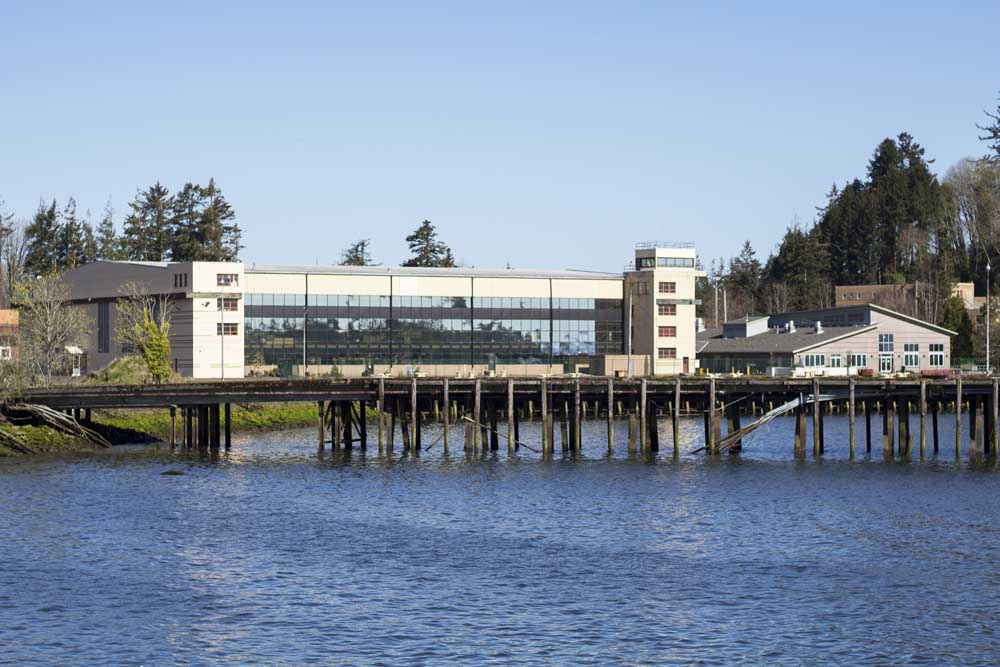Elk invade Gearhart
Published 4:00 pm Friday, January 24, 2014

- <p>Rachel Speakman, of Gearhart, is the student representative on the Gearhart City Council. A junior at Astoria High School, Speakman is collaborating with local officials and environmentalists to develop a plan to deal with the herds of elk that frequently pass through Gearhart.</p>
They march through Gearhart, at least 50-strong strolling in the early morning light, causing passersby to stop and gawk and pull out their cellphones to snap photos.
The dozens of marching elk have become a staple of the area each winter, walking their well-worn path through the yards, meadows, golf courses and streets of Gearhart.
Though elk have always been a common wintertime sight, the Gearhart herd has increased in size, bringing added challenges to the community.
We havent seen a herd this size, said Neal Maine, a local nature photographer and conservationist who tracks the elk.
Having such beautiful, awe-inspiring creatures so close to home brings both pluses and minuses.
Theres the good and the bad, Maine said. People do enjoy seeing wildlife, so having a herd of elk in your neighborhood if theyre not ruining your stuff then people like it.
The stuff that the elk generally ruin includes shrubs, vines and other landscaping features in residents yards, especially nonnative plants like escallonia, which, unlike most native vegetation, is perennial rather than seasonal.
This means that, in the leaner winter months when theyve picked their usual feeding grounds clean, the elk seek out the nonnative plants. Nonnatives tend to be vines or shrubs in peoples yards and are the most nutritious snack available in the winter.
A lot of the domestics are seasonal, Maine said. Thats why they target the ivy: its green as can be.
Though elk, which love the coastal setting, according to Maine, have always been a common sight in the Gearhart area, the increased size of the herd has wreaked havoc on residents yards especially the towns two biggest lawns, the golf courses.
Matt Brown, head professional at the Highlands Golf Course, and Forrest Goodling, superintendent of Gearhart Golf Links, have certainly noticed a difference in the past couple of years.
Grazing elk had always been an issue, but not to this intensity, Brown said. Usually every winter, for the period of a couple weeks to a month, there would be a small group of elk, usually 20 to 25 … and theyd cause a little bit of damage. But whats happened the last two years is that small group or that herd, instead of coming around for a little bit and leaving, its just stayed here.
The sheer size of the herd is the biggest issue, according to Brown.
That herd now has grown to … anywhere from 50 to 75, he said. I think our grounds crew has counted even more than that. Now whats happening, is that, instead of leaving across the highway, theyre staying here year-round.
The increased herd size has caused Goodling, who oversees the maintenance of the Gearhart Golf Links, considerable consternation.
I think 10 or 15 elk were manageable, but when the herd gets up to 60 or 80, then the damage is significant, he said. It gets to be dangerous, its unsanitary, theres droppings everywhere. … Last year we spent about 25,000 bucks repairing greens, keeping the elk off the greens.
Herman Biederbeck, the Oregon Department of Fish and Wildlife’s wildlife biologist for the North Coast district, said that elk will always flock to spaces like golf courses.
“The bottom line is, short of building an elk-proof fence, it’s impossible to keep the elk off of places like golf courses,” Biederbeck said. “How you deal with elk on the golf courses really determines how much damage there is.
“When people see elk on the golf course and they slowly move them off, the damage to the golf course tends to be minimized,” Biederbeck said. “The last thing you want to do when there’s a herd of elk on a golf course is scare them off quickly, because that’s when they’re going to do more damage with their hooves.”
Because elk are ruminants and require substantial sustenance, a few dozen elk foraging in a community can have a significant impact on the areas vegetation.
They need about nine to 10 pounds of natural material each day, each one of them, Maine said, and they can consume up to 20 pounds of vegetation daily, according to the U.S. Fish and Wildlife Service.
The ubiquity of the elk this winter has forced the city of Gearhart to discuss its options in handling the herd.
Its a concern, said Gearhart Mayor Dianne Widdop. The citys residents must learn how to cohabitate with the elk, because theyre here to stay, she added.
Members of the Gearhart City Council, Maine, Widdop, Gearhart City Administrator Chad Sweet, Biederbeck and the councils student representative, Rachel Speakman, are busying formulating a plan to deal with the elk. Speakman will present a report to the council.
Widdop suggested that Speakman investigate the elk situation and brainstorm ways to raise awareness about the issue, said Speakman, a junior at Astoria High School.
Speakmans family lives on Pacific Way, which has become a major thoroughfare for the herd. Speakman recounted a recent early morning wake-up call from the elk.
I woke up at 2 in the morning and looked out the window because the dog was barking, she said. There were a good 40 elk in our yard, eating our escallonia, just lounging for about an hour.
Maine stressed that the elk were browsers. Though they will happily eat your shrubs, they wont take up permanent residence in a neighborhood.
They will move on, he said. They may strip your ornamental shrub piece to do that, but they will move.
The elk’s motivation is fairly straightforward, according to Maine.
“It’s really pretty much food and sex that drives their lives,” he said.
The herd is simply following the food.
For the elk, there is no Gearhart: If you keep saying Gearhart, or city, people get the idea that, in some way or another, the land has different zones or lines on it, Maine said. For the elk, its just habitat, and they have 1 million years of genetics saying get food. They dont have something saying, get someones backyard.
Its tough for us because we keep thinking like a person, and we need to think like an elk, Maine said.
Rather than thinking of the elk situation as a problem with a simple solution, it may simply be a matter of finding a way to coexist with animals that haven been abundant on the Pacific Coast since at least the 19th century, according to the Oregon Department of Fish and Wildlife.
There arent a lot of good options thats the catch, Maine said. Its finding a way to live with them.
Widdop thinks that something as simple as notifying the public of some of the dos and donts of interacting with elk would be hugely helpful.
We want to do some signage at the beach, at the beach pass, just to let people know these are not pets, the mayor said. And if your dog runs loose, it could be killed its just the way it goes.
Hopefully, signs are on the top of our list right now, said Speakman, who also mentioned fliers or posting on the citys blog to help raise awareness about dealing with the sizable elk herd. Something people would actually notice and want to read.
Maine has also floated the idea of attaching a GPS-tracking unit on the herds lead cow, which would allow observers to track the elk and prepare for them. If someone knows the elk are approaching, the animals can be herded by slowly and carefully driving a truck or golf cart toward them, Maine said.
It is important that the elk are not approached at high speeds or chased, however, whether it be by car, cart or dog.
The damage they do with their hooves and crashing through fences is usually through some active chase activity, Maine said.
If someone wants a photo of the elk herd, Maine suggests buying a decent camera with a zoom: Hes seen enough people get out of their cars, cellphone in hand, trying to get as close to the herd as they can to know its a bad idea.
Dont try to close the gap, because youll push them to do things, he said. They can panic, and then we have chaos.
If residents dont want elk in their yards, they’re encouraged to plant seasonal, domestic plants rather than the more exotic nonnatives often popular in landscaping.
“The people that tend to have the most problems are the people who have the most manicured landscape to their yard,” Biederbeck said. “The people who have more of a natural-type landscaping tend to have the fewest problems.”
Biederbeck said that one of the reasons that native plants deter elk is that they have built up natural defenses.
“Native plants have evolved to coexist with heribovers like deer and elk,” he said. “So that means that they have probably evolved some defense so they’re not just annihilated by foraging deer and elk.”
If someone really wants ornamental, nonnative plants in their yard, Biederbeck suggests keeping them away from foraging elk, either by erecting a fence or surrounding them by less palatable plants.
“If you have highly desirable plants in your yard, the best solution is to put a physical barrier between the animals and those plants,” he said.
All those involved in the discussions in Gearhart hope to raise awareness and develop an approach so the elk can be appreciated as a remarkable creature, not a neighborhood nuisance.
I think if we can get it all organized and process the information, we can get the ball rolling and see what we can get done with this, Speakman said.





